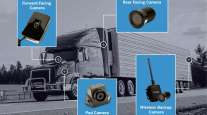Perspective: Drivers Seek Improvements on Routes
An annual survey of thousands of drivers found that while most are happy with the pay structure their fleets offer, they see room for improvement with how their routes are selected.
Among nearly 8,400 drivers and owner-operators surveyed across more than 145 fleets, 89% of respondents to the annual “Best Fleets to Drive For” survey felt that their company’s pay model was working for them, and 88% felt that they were compensated fairly. The number of responses set a record for the annual evaluation of workplaces in the North American trucking industry, conducted jointly by CarriersEdge and the Truckload Carriers Association.
Compared with last year’s responses, the number of companies offering guaranteed pay jumped 10%. In fact, more than half of the companies listed offered some variation of guaranteed pay. The results also indicated that drivers are becoming more interested in profit sharing or stock option programs, things that 21% of the companies that landed in the list’s top 20 offer.

Jazrawy
These findings suggest that fleets must look beyond the decades-old practice of simply boosting per-mile pay or offering big sign-on bonuses to attract and retain drivers. In reality, drivers want a steady paycheck. They have bills to pay, and if their paycheck varies widely, it becomes a real pain point. After all, what is the point of a 3-cent per-mile increase if there is a road closure or if there are other factors preventing a truck driver from accumulating miles?
On this last point — and a few others — drivers would like to see change come to the industry.
Determining Routes: For years, we have asked drivers if their fleets have a fair method of determining routes, and each year, we receive responses informing us that things could be better. This year, 53% felt in strong alliance with the company’s routing practices, but that means slightly fewer than half of drivers did not.
When we examined these fleets, we noticed that they all have similar scheduling processes: assigning loads based on proximity, available hours, driver preferences and several other variables.
Fleets may sometimes struggle with clarifying the routing process and explaining why specific routes are given to drivers and not others, but drivers need to feel like they have the opportunity to share their suggestions about their routes. Bottom line: Fleets must be open about the decisions they are making, because a well-balanced, internal communication system alleviates the questioning of decisions being made by office staff.
That’s tough when you have a mobile work force, and this year’s survey respondents said results vary considerably depending on whether a company is using modern meeting tools or relying on in-person events.
Company Meetings: The trick to company meetings is to get everyone involved in a format that works. Drivers want to have meetings so that they can have an opportunity to engage the company, but some fleets are quick to write off meetings because their drivers are all out on the road. But it’s important to have regular meetings so that everyone feels connected to the company.
And they no longer need to be in-person. The internet can be accessed nearly anywhere, so companies no longer have the excuse of, “It’s too tough to bring in the entire fleet to headquarters for a simple meeting.” Facebook Live, WebEx and GoToMeeting are a few platforms some companies are using as solution to host meetings.
Facebook and other social media also offer another means of outreach to drivers.
Social Media: Many fleets use social media to boost their brand awareness, but there is a lot of room for fleets to improve their engagement among their drivers.
More than 75% of driver respondents reported being active on social media, but only 58% of them followed their own company on various social media platforms. But if drivers followed their companies’ social media posts, they might share those posts, which in turn helps the company expand its reach.
Social media is a widely used used tool, and fleets that are not actively embracing this technology are lagging behind.
Happy Drivers: Despite these challenges, 82% of respondents said they would likely recommend their current company to other drivers, and nearly all of them said they would like to stay with their company for the rest of their career. A characteristic of the companies that land on the Best Fleets list is that they are always searching for creative ways to improve their operation and the livelihoods of their drivers.
After all, if a fleet isn’t self-assessing its operation, how can it ever improve?
Jane Jazrawy is CEO of CarriersEdge, which provides online driver training for the trucking industry. She is co-creator of Best Fleets to Drive For, which is produced in partnership with the Truckload Carriers Association.




